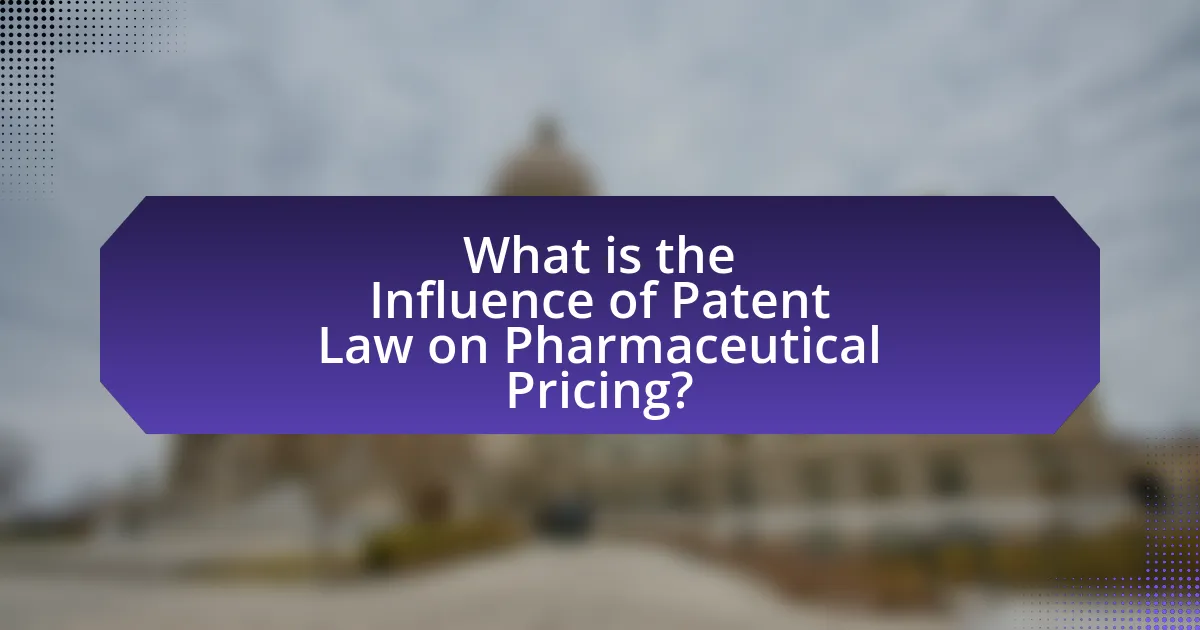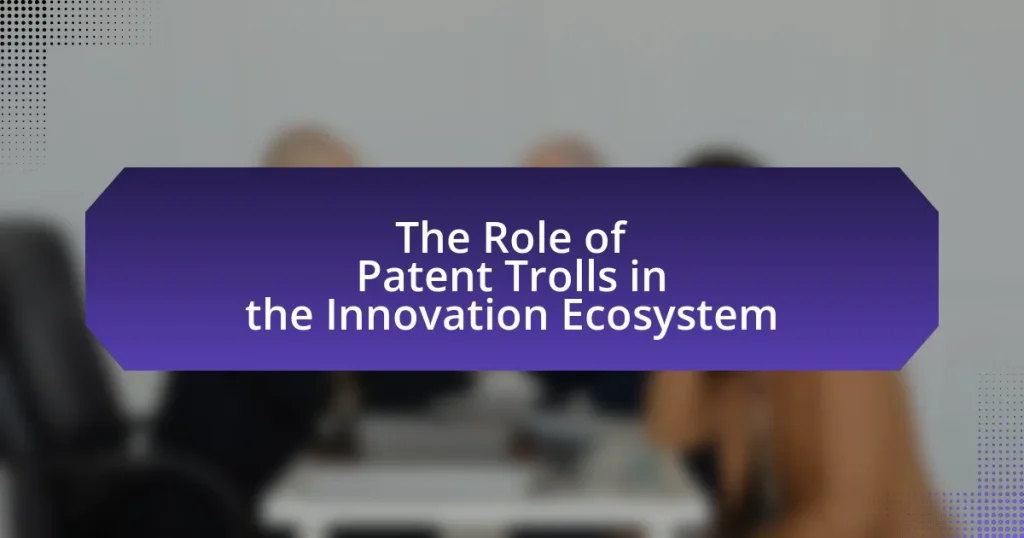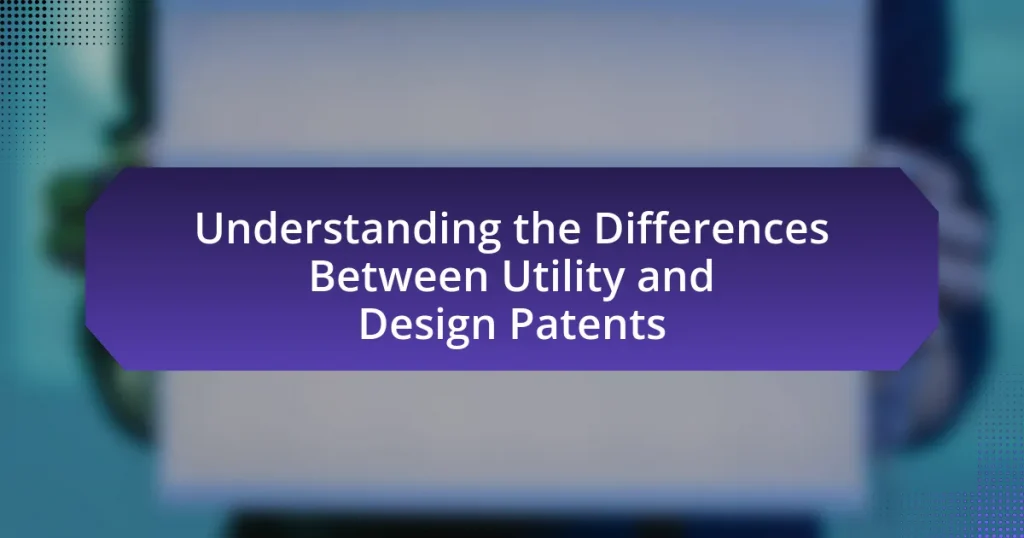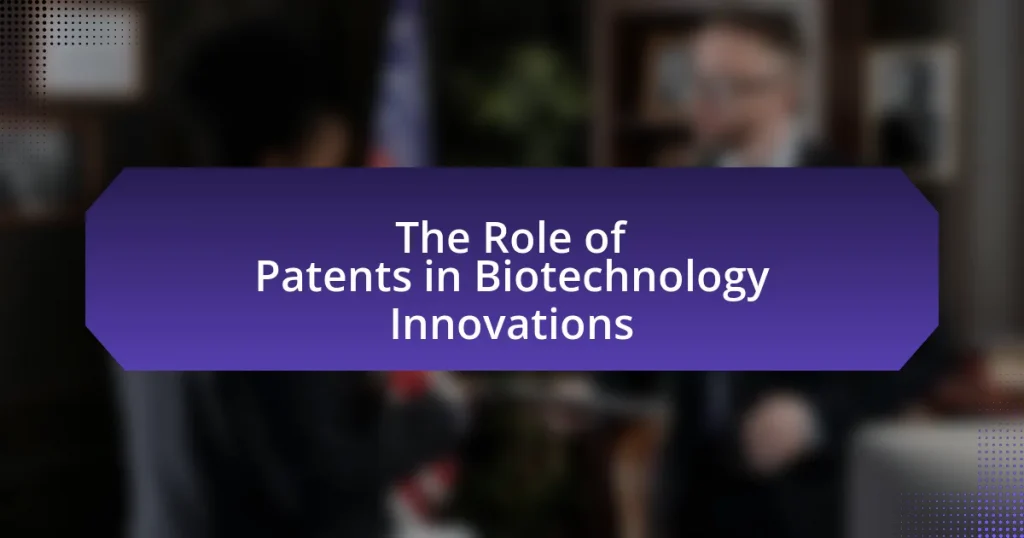Patent law plays a crucial role in shaping pharmaceutical pricing by granting manufacturers exclusive rights to sell their drugs for a limited period, typically 20 years. This exclusivity allows companies to set higher prices, recouping substantial research and development costs, which can exceed $2.6 billion per new drug. However, it also leads to increased costs for consumers and healthcare systems, as seen with high-profile medications like Sovaldi and EpiPen. The article explores how patent law influences pricing strategies, market exclusivity, and the implications for drug accessibility, particularly in the context of patent expirations and international patent regulations. Understanding this relationship is essential for addressing the balance between fostering innovation and ensuring affordable access to medications.

What is the Influence of Patent Law on Pharmaceutical Pricing?
Patent law significantly influences pharmaceutical pricing by granting exclusive rights to manufacturers for a specified period, allowing them to set higher prices without competition. This exclusivity incentivizes innovation by enabling companies to recoup research and development costs, which can average over $2.6 billion per new drug. However, it also leads to elevated prices for consumers, as seen with drugs like Gilead’s Sovaldi, priced at $1,000 per pill, reflecting the lack of generic alternatives during the patent period. Consequently, while patent law fosters drug development, it simultaneously contributes to high pharmaceutical costs, impacting accessibility and affordability for patients.
How does patent law affect the pricing strategies of pharmaceutical companies?
Patent law significantly influences the pricing strategies of pharmaceutical companies by granting them exclusive rights to sell their inventions for a limited time, typically 20 years. This exclusivity allows companies to set higher prices for patented drugs without competition, enabling them to recoup research and development costs. For instance, the average cost to develop a new drug can exceed $2.6 billion, and patent protection helps ensure that companies can achieve profitability during the patent period. Additionally, the presence of patents can lead to price discrimination, where companies charge different prices in different markets based on factors like income levels and healthcare systems. This pricing strategy is evident in the global pharmaceutical market, where patented drugs are often sold at significantly higher prices in developed countries compared to developing nations.
What are the key components of patent law that impact pharmaceutical pricing?
The key components of patent law that impact pharmaceutical pricing include patent exclusivity, patent duration, and the ability to enforce patent rights. Patent exclusivity allows pharmaceutical companies to set prices without competition for a specified period, typically 20 years from the filing date, which can lead to higher prices due to lack of generic alternatives. The duration of patents directly affects the time frame in which companies can recoup research and development costs, influencing pricing strategies. Additionally, the enforcement of patent rights enables companies to prevent generic manufacturers from entering the market, further sustaining high prices until patents expire or are challenged. These components collectively shape the pricing landscape in the pharmaceutical industry.
How do patents create market exclusivity for pharmaceutical products?
Patents create market exclusivity for pharmaceutical products by granting the patent holder the sole right to manufacture, sell, and distribute the patented drug for a specified period, typically 20 years from the filing date. This exclusivity prevents other companies from producing generic versions of the drug, allowing the patent holder to set higher prices without competition. For example, the patent for the blockbuster drug Lipitor, which generated over $125 billion in sales during its patent life, illustrates how patent protection can lead to significant financial returns for pharmaceutical companies. The absence of generic alternatives during the patent term enables the patent holder to recoup research and development costs and fund future innovations.
Why is understanding the relationship between patent law and pharmaceutical pricing important?
Understanding the relationship between patent law and pharmaceutical pricing is crucial because patent law directly influences the cost and availability of medications. Patent protections grant pharmaceutical companies exclusive rights to sell their products, allowing them to set higher prices without competition. For instance, the average cost of a new drug can exceed $2.6 billion, largely due to the need to recoup research and development expenses during the patent period. This exclusivity can lead to significant financial burdens on healthcare systems and patients, as seen with high-profile cases like the EpiPen price increase, where the lack of generic alternatives due to patent protections allowed for price hikes. Therefore, comprehending this relationship is essential for policymakers and stakeholders aiming to balance innovation incentives with public health needs.
What implications does this relationship have for consumers and healthcare systems?
The relationship between patent law and pharmaceutical pricing significantly impacts consumers and healthcare systems by influencing drug affordability and accessibility. High patent protections often lead to monopolistic pricing, which can result in increased out-of-pocket costs for consumers and strain on healthcare budgets. For instance, a study published in Health Affairs found that brand-name drugs can cost up to 10 times more than their generic counterparts due to patent exclusivity, limiting access for patients who cannot afford these prices. Consequently, healthcare systems may face higher expenditures on medications, leading to increased insurance premiums and reduced funding for other essential services.
How does patent law influence innovation in the pharmaceutical industry?
Patent law significantly influences innovation in the pharmaceutical industry by providing exclusive rights to inventors for a limited time, which incentivizes research and development. This exclusivity allows pharmaceutical companies to recoup the substantial costs associated with drug development, which can exceed $2.6 billion per new drug, according to a study by the Tufts Center for the Study of Drug Development. By protecting intellectual property, patent law encourages investment in innovative treatments and therapies, as companies are assured that their inventions will not be easily replicated by competitors during the patent term, typically lasting 20 years from the filing date. This legal framework fosters an environment where pharmaceutical firms are motivated to innovate, ultimately leading to advancements in medical science and improved patient outcomes.

What are the effects of patent expiration on pharmaceutical pricing?
Patent expiration significantly reduces pharmaceutical pricing by allowing generic drug manufacturers to enter the market. When a patent expires, the exclusive rights held by the original manufacturer end, leading to increased competition from generics, which typically sell at lower prices. For instance, after the patent expiration of Lipitor, a cholesterol-lowering medication, prices dropped by approximately 90% within a year due to the introduction of generic alternatives. This price reduction benefits consumers and healthcare systems by making medications more affordable and accessible.
How does the expiration of patents lead to price reductions in pharmaceuticals?
The expiration of patents leads to price reductions in pharmaceuticals by allowing generic manufacturers to produce and sell equivalent drugs at lower prices. When a patent expires, the exclusive rights of the original manufacturer cease, enabling multiple companies to enter the market with generic versions, which typically cost significantly less due to lower research and development expenses and increased competition. For instance, after the patent expiration of the cholesterol-lowering drug Lipitor in 2011, prices dropped by over 80% as generic alternatives became available. This competitive environment drives prices down, benefiting consumers and healthcare systems.
What role do generic drugs play in the pricing landscape post-patent expiration?
Generic drugs significantly lower prices in the pharmaceutical landscape after patent expiration. Once a brand-name drug’s patent expires, generic versions enter the market, leading to increased competition. This competition typically results in substantial price reductions; for instance, the average price of generic drugs is often 80% lower than their brand-name counterparts. According to a study by the AARP, the introduction of generics can lead to a decrease in overall drug spending, saving consumers billions annually. Thus, generic drugs play a crucial role in making medications more affordable and accessible following patent expiration.
How do pharmaceutical companies respond to the threat of generic competition?
Pharmaceutical companies respond to the threat of generic competition by implementing strategies such as patent extensions, product reformulations, and aggressive marketing campaigns. These companies often seek to extend their patent protections through legal means, such as filing for additional patents on new formulations or delivery methods of existing drugs, which can delay the entry of generics into the market. For instance, the practice of “evergreening” allows companies to maintain market exclusivity by making minor modifications to their products. Additionally, pharmaceutical firms may engage in direct competition by lowering prices or increasing promotional efforts for their branded drugs to retain market share. According to a study published in the Journal of Health Economics, these strategies can effectively reduce the impact of generics on sales, demonstrating that companies actively seek to mitigate the financial risks posed by generic alternatives.
What are the economic consequences of patent expirations for pharmaceutical companies?
Patent expirations lead to significant economic consequences for pharmaceutical companies, primarily through the loss of exclusive market rights and subsequent revenue declines. When a patent expires, generic versions of the drug can enter the market, often resulting in a dramatic price drop; for instance, studies show that prices for branded drugs can decrease by 80% or more within a year of generic entry. This increased competition typically leads to a substantial reduction in sales for the original patent-holding company, with some estimates indicating that companies can lose up to 90% of their market share for that drug shortly after patent expiration. Furthermore, the financial impact extends beyond individual products, as the overall revenue decline can affect the company’s ability to invest in research and development for new drugs, potentially stifling innovation in the long term.
How do companies strategize to maintain profitability after patent loss?
Companies strategize to maintain profitability after patent loss by diversifying their product lines, enhancing operational efficiencies, and focusing on brand loyalty. Diversification allows companies to introduce new products or enter new markets, which can offset revenue declines from lost patents. For instance, pharmaceutical companies often invest in research and development for new drugs or therapeutic areas to create a pipeline of products that can generate revenue. Enhancing operational efficiencies, such as optimizing supply chains or reducing production costs, helps maintain margins despite increased competition from generics. Additionally, companies may leverage brand loyalty through marketing strategies that emphasize the quality and reliability of their products, encouraging consumers to choose their brand over cheaper alternatives. These strategies are supported by historical data showing that companies that successfully innovate or optimize operations post-patent loss can sustain or even grow their profitability.
What impact does patent expiration have on research and development funding?
Patent expiration significantly reduces research and development funding in the pharmaceutical industry. When patents expire, generic alternatives enter the market, leading to decreased revenues for original brand-name drugs. This revenue decline can result in pharmaceutical companies reallocating resources away from R&D, as they may prioritize cost-cutting measures to maintain profitability. For instance, a study published in the Journal of Health Economics found that after patent expiration, R&D spending by pharmaceutical firms decreased by approximately 20% on average, as companies faced increased competition and lower profit margins. This trend indicates that patent expiration directly impacts the financial resources available for innovation and development of new drugs.

How do international patent laws influence pharmaceutical pricing globally?
International patent laws significantly influence pharmaceutical pricing globally by granting exclusive rights to manufacturers, which allows them to set higher prices for patented drugs. These laws, established through agreements like the Agreement on Trade-Related Aspects of Intellectual Property Rights (TRIPS), require member countries to protect patents for a minimum of 20 years. This exclusivity can lead to monopolistic pricing, as companies can recoup research and development costs without competition. For example, a study published in the Journal of Health Economics found that countries with stronger patent protections tend to have higher drug prices, as the lack of generic alternatives allows patent holders to maintain elevated pricing structures.
What are the differences between patent laws in various countries?
Patent laws differ significantly across countries in terms of duration, scope, and enforcement mechanisms. For instance, the United States grants a patent term of 20 years from the filing date, while many European countries also adhere to this duration but have specific provisions for supplementary protection certificates that can extend the patent term for pharmaceuticals by up to five years. Additionally, countries like India have stricter criteria for patentability, particularly regarding pharmaceutical inventions, often requiring a demonstration of enhanced efficacy over existing drugs, which contrasts with the more lenient standards in the U.S. and Europe. Enforcement varies as well; the U.S. has a robust litigation system that allows for significant damages, while in some developing countries, enforcement may be weak due to limited resources and legal frameworks. These differences impact pharmaceutical pricing, as countries with stronger patent protections often see higher drug prices due to the monopolistic advantages granted to patent holders.
How do these differences affect drug pricing in different markets?
Differences in patent laws significantly affect drug pricing in various markets by determining the duration and scope of market exclusivity for pharmaceutical companies. In countries with strong patent protections, such as the United States, companies can maintain higher prices due to limited competition from generic alternatives, often resulting in prices that can be several times higher than in markets with weaker patent enforcement. For instance, a study published in Health Affairs found that brand-name drugs in the U.S. were priced 4.5 times higher than in countries with price controls and robust generic markets, like Canada. Conversely, in markets with less stringent patent laws, generic drugs can enter the market sooner, leading to lower prices and increased accessibility for consumers. This disparity illustrates how variations in patent law directly influence the affordability and availability of medications across different regions.
What challenges do pharmaceutical companies face in navigating international patent laws?
Pharmaceutical companies face significant challenges in navigating international patent laws, primarily due to the complexity and variability of legal frameworks across different countries. These companies must contend with differing patent durations, enforcement mechanisms, and criteria for patentability, which can lead to uncertainty in protecting their intellectual property. For instance, while some countries may grant patents for new uses of existing drugs, others may not, complicating global strategies for drug development and commercialization. Additionally, the existence of international agreements, such as the Agreement on Trade-Related Aspects of Intellectual Property Rights (TRIPS), imposes minimum standards but allows for considerable national discretion, resulting in inconsistent application and enforcement of patent rights. This inconsistency can lead to challenges in pricing strategies, as companies may face generic competition in some markets sooner than anticipated, impacting their revenue and investment in research and development.
How do trade agreements impact patent law and pharmaceutical pricing?
Trade agreements significantly influence patent law and pharmaceutical pricing by establishing international standards for intellectual property protection and enforcement. These agreements often extend patent durations and enhance protections for pharmaceutical companies, which can lead to higher drug prices due to reduced competition. For instance, the Trade-Related Aspects of Intellectual Property Rights (TRIPS) agreement mandates that member countries provide at least 20 years of patent protection, which can delay the entry of generic drugs into the market. This extended exclusivity allows pharmaceutical companies to maintain higher prices for longer periods, impacting overall healthcare costs. Additionally, trade agreements may include provisions that limit countries’ ability to use compulsory licensing, further restricting access to affordable medications.
What role do organizations like the WTO play in shaping patent law?
Organizations like the WTO play a crucial role in shaping patent law by establishing international agreements that set standards for intellectual property protection, including patents. The WTO’s Agreement on Trade-Related Aspects of Intellectual Property Rights (TRIPS) mandates member countries to adhere to minimum patent protection standards, which influences national patent laws and practices. For instance, TRIPS requires that patents be granted for a minimum of 20 years, impacting how countries regulate pharmaceutical patents and, consequently, drug pricing. This framework aims to balance the interests of patent holders and public health, as seen in the ongoing debates about access to medicines in developing countries.
How can changes in international patent law affect drug accessibility in developing countries?
Changes in international patent law can significantly affect drug accessibility in developing countries by altering the balance between patent protection and the availability of affordable medications. When patent laws become stricter, pharmaceutical companies gain extended monopolies on drug production, leading to higher prices and reduced access for patients in developing nations. For instance, the implementation of the Trade-Related Aspects of Intellectual Property Rights (TRIPS) agreement in 1995 initially restricted the ability of these countries to produce generic versions of patented drugs, resulting in increased costs for essential medications like antiretrovirals for HIV/AIDS. Conversely, reforms that allow for more flexible patent regulations, such as compulsory licensing, can enable local manufacturers to produce generic drugs, thereby lowering prices and improving accessibility. The World Health Organization has noted that countries with more lenient patent laws often see better health outcomes due to increased availability of affordable medicines.
What best practices can pharmaceutical companies adopt to navigate patent law effectively?
Pharmaceutical companies can navigate patent law effectively by implementing a robust intellectual property strategy that includes thorough patent searches, regular monitoring of patent expirations, and proactive engagement in patent litigation. Conducting comprehensive patent searches ensures that companies are aware of existing patents that may affect their products, thereby reducing the risk of infringement. Regular monitoring of patent expirations allows companies to plan for generic competition and adjust pricing strategies accordingly. Proactive engagement in patent litigation, when necessary, can protect a company’s market position and deter potential infringers. These practices are supported by the fact that companies that actively manage their patent portfolios tend to maintain a competitive edge in the market, as evidenced by the success of firms that invest in patent analytics and legal expertise to navigate complex patent landscapes.



